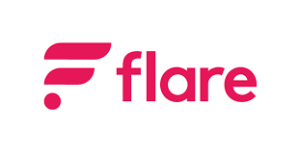Latest News
- Crypto Crash Ahead? Bitcoin Nears $85K After Trump’s Tariff Pause, But Risks Loom
- Cryptocurrency Price Prediction: Will Trump Undo 90D Tariff Pause, triggering Stock and Crypto Market Crash?
- Flare (FLR) surges 57% in a week as technicals flash overbought
- Flare (FLR) Hits a Weekly High with 57% Surge as Indicators Signal More Upside
Current Price
The current price of FLR is $0.01633
Introduction
Flare ($FLR) presents a compelling case for enhancing the functionality of blockchain networks, particularly through its integration with non-Turing complete systems such as XRP.
By leveraging the Ethereum Virtual Machine and the innovative Flare Consensus Protocol, it aims to foster interoperability and broaden asset utilization.
As the decentralized finance landscape evolves, understanding Flare’s unique features and potential implications for investors becomes increasingly pertinent.
What remains to be examined, however, is the extent of its market performance and the prospects it holds for future growth.
Quick Overview
- Flare enables smart contracts on non-Turing complete networks, enhancing blockchain utility and interoperability through its innovative consensus mechanisms.
- The Flare Time Series Oracle (FTSO) provides real-time asset pricing, improving the reliability and functionality of decentralized applications (dApps) on the network.
- The Spark ($FLR) token serves governance and incentivization purposes, allowing participants to engage in decision-making and benefit from staking mechanisms.
- Flare’s recent partnerships and integrations within the DeFi space position it as a potential cornerstone asset in the rapidly evolving blockchain ecosystem.
- Investors can benefit from Flare’s innovative features, which enhance asset utility and offer opportunities for passive income through staking and DeFi applications.

Overview of Flare (FLR)
Flare (FLR) emerges as a decentralized network designed to enhance the utility of blockchain ecosystems by enabling smart contract functionality on non-Turing complete networks, such as XRP. This innovation addresses the limitations posed by traditional blockchains that cannot execute complex smart contracts, thereby expanding the scope of decentralized applications (dApps) across various platforms.
At its core, Flare utilizes the Ethereum Virtual Machine (EVM) to facilitate a seamless integration of smart contract capabilities, allowing developers to build and deploy dApps with ease. By bridging the gap between Turing complete and non-Turing complete networks, Flare aims to reveal new potential for asset utilization, fostering greater liquidity and interoperability within the blockchain space.
Moreover, Flare employs a unique consensus mechanism, the Flare Consensus Protocol, which enhances security and scalability. This approach not only supports the creation of dApps but also enables the incorporation of unique assets from other blockchains, thereby enriching the Flare ecosystem.
To summarize, Flare positions itself as a pivotal player in the blockchain landscape, offering innovative solutions that cater to the evolving needs of developers and users alike.
Unique Features of Flare
Flare distinguishes itself through its robust interoperability with other blockchain networks, enabling seamless asset transfers and communication.
Additionally, its smart contract functionality allows for the utilization of various assets, enhancing the platform’s versatility and utility.
These unique features position Flare as a significant player in the evolving landscape of decentralized finance.
Interoperability With Other Chains
At the forefront of blockchain innovation, Flare stands out for its unique interoperability features that facilitate seamless communication between disparate networks. This capability is essential in today’s rapidly evolving digital landscape, where isolated blockchain ecosystems often hinder potential efficiencies and synergies.
Flare achieves interoperability primarily through its novel consensus mechanism and the Flare Time Series Oracle (FTSO), enabling it to connect with established chains like Ethereum and Ripple.
By allowing smart contracts to access and utilize data from multiple blockchains, Flare creates a versatile environment where assets and information can flow freely. This approach not only enhances liquidity across networks but also fosters the development of decentralized applications (dApps) that can harness the strengths of various ecosystems.
As a result, developers can build more robust solutions that leverage the unique attributes of each blockchain, ultimately driving innovation.
Furthermore, Flare’s focus on integrating non-Turing complete chains into its framework allows for a broader range of assets to be utilized in smart contracts, enhancing the overall utility of the platform.
This interoperability positions Flare as a pivotal player in the blockchain space, paving the way for collaborative growth and enhanced functionality across the crypto ecosystem.
Smart Contracts for Assets
The innovative interoperability features of Flare not only facilitate communication between different blockchain networks but also enhance the utility of smart contracts, particularly concerning assets. By enabling the integration of non-Turing complete blockchains with smart contracts, Flare extends the functionality of traditional assets, allowing them to be utilized in decentralized finance (DeFi) applications and other ecosystems.
One of the standout features of Flare is its ability to bring smart contracts to assets like Bitcoin and Litecoin through the Flare Time Series Oracle (FTSO). This mechanism allows for the accurate pricing of assets in real time, thereby improving the reliability of decentralized applications.
Additionally, Flare’s use of the Ethereum Virtual Machine (EVM) guarantees that developers can easily deploy existing Ethereum-based smart contracts on its platform, thereby enhancing the overall utility of these assets.
Moreover, Flare’s unique approach to collateralization allows users to access liquidity from their assets while still retaining ownership. This innovative model not only increases the financial flexibility of users but also demonstrates the potential for more complex, multi-asset smart contracts that can redefine asset management in the blockchain space.

How Flare Works
A decentralized network known as Flare operates by integrating various blockchain ecosystems to enable the seamless transfer of data and value. At its core, Flare utilizes the Ethereum Virtual Machine (EVM) to support smart contracts, extending the functionality of existing blockchains beyond their native capabilities. This integration allows assets from networks such as XRP and Bitcoin to interact with decentralized applications (dApps) on Flare, facilitating cross-chain transactions without compromising security or decentralization.
Flare employs a unique consensus mechanism called the Federated Byzantine Agreement (FBA), which enhances transaction speed and finality. By leveraging a network of independent validators, Flare achieves greater scalability while ensuring that the integrity of the blockchain remains intact.
Additionally, the network utilizes the Spark (FLR) token, which plays a crucial role in governance and incentivization, allowing users to participate in decision-making processes that affect the network’s future.
Furthermore, Flare’s innovative use of oracles enables real-time data integration, allowing smart contracts to access external information securely. This capability opens up new possibilities for decentralized finance (DeFi) applications and other blockchain use cases, promoting a more interconnected and functional ecosystem.
Benefits for Investors
Investors in Flare (FLR) can potentially benefit from significant returns due to the platform’s innovative approach to interoperability and smart contract functionality.
The unique ecosystem allows participants to engage in various decentralized finance (DeFi) applications, enhancing their investment strategies.
This combination of high return potential and active ecosystem participation positions Flare as an attractive opportunity in the cryptocurrency market.
Potential for High Returns
Flare (FLR) presents a compelling opportunity for those seeking high returns in the evolving cryptocurrency landscape. As an innovative platform designed to enhance interoperability among blockchains, Flare leverages its unique technology to enable smart contract capabilities on networks that traditionally lack them. This positions FLR as a potentially lucrative asset, especially as demand for cross-chain solutions continues to rise.
The project’s focus on integrating various digital assets and enhancing liquidity offers a dual benefit: not only does it attract investors looking for diversified opportunities, but it also opens pathways for increased utility and adoption.
As Flare’s ecosystem grows, the likelihood of significant price appreciation becomes more plausible, particularly if the platform successfully captures market share in the burgeoning DeFi sector.
Moreover, Flare’s tokenomics, which include mechanisms for incentivizing participation and staking, further enhance the potential for high returns. Investors can benefit from both price appreciation and passive income streams through staking rewards.
As the cryptocurrency market matures, those who enter early and strategically may find Flare to be a pivotal player in their portfolio, driving substantial returns in the years ahead.
Unique Ecosystem Participation
The unique ecosystem of Flare offers significant advantages for participants, fostering an environment conducive to both innovation and investment. Central to Flare’s appeal is its ability to integrate various blockchain networks, facilitating interoperability that enhances liquidity and utility. By enabling assets from different ecosystems to interact seamlessly, Flare positions itself as a critical infrastructure layer in the decentralized finance (DeFi) landscape.
Investors benefit from Flare’s innovative approach through unique staking mechanisms and decentralized applications (dApps), which not only provide passive income opportunities but also promote active participation in governance.
The Flare network’s focus on smart contracts allows for the development of diverse financial products that cater to a broad range of investor preferences, thereby encouraging a dynamic investment landscape.
Moreover, the ecosystem’s emphasis on community engagement guarantees that participants have a voice in the network’s evolution, fostering a sense of ownership. As the Flare ecosystem continues to grow, it creates potential for long-term value appreciation, attracting investors seeking sustainable growth avenues.
Use Cases in DeFi
Numerous use cases for Flare (FLR) in the decentralized finance (DeFi) ecosystem highlight its versatility and potential impact. One of the most significant applications of FLR is its integration with the Flare Time Series Oracle, which facilitates real-time data access for smart contracts. This capability allows developers to create sophisticated financial products that require accurate and timely information, such as derivatives and automated market makers.
Another critical use case is the interoperability that FLR offers, enabling assets from various blockchains to be utilized within the DeFi space. By bridging assets like Bitcoin and XRP, Flare enhances liquidity and broadens investment opportunities, thereby attracting a diverse range of users.
Additionally, FLR tokens can be utilized for governance purposes, allowing holders to participate in decision-making processes regarding protocol upgrades and changes, consequently fostering a democratic ecosystem.
Furthermore, Flare’s approach to decentralized lending and borrowing, where collateral can be in the form of various digital assets, broadens the scope for DeFi participants. This innovative framework positions Flare as a pivotal player in the evolving landscape of decentralized finance, driving greater accessibility and efficiency in financial transactions.
Market Performance Analysis
In recent months, the market performance of Flare (FLR) has showcased both resilience and volatility, reflecting broader trends within the cryptocurrency market. Following its initial launch, FLR experienced significant price fluctuations, typical of emerging digital assets. These variations can be attributed to several factors, including investor sentiment, market liquidity, and developments within the Flare ecosystem itself.
Despite the inherent volatility, FLR has demonstrated a capacity to recover from downturns, indicating a degree of investor confidence. Trading volumes have seen periodic spikes, often correlating with announcements related to partnerships or technological advancements, suggesting that market participants remain engaged with the project’s potential.
Additionally, FLR’s integration within the decentralized finance (DeFi) landscape appears to bolster its market presence, as users seek out innovative solutions that leverage its unique capabilities.
Comparatively, FLR’s price movements align with key market events affecting cryptocurrencies at large, further emphasizing the interconnected nature of the sector.
Future Prospects and Potential
Market trends and investor sentiment surrounding Flare (FLR) suggest a promising outlook for its future prospects. As the blockchain ecosystem continues to evolve, Flare’s unique value proposition of enabling interoperability among various blockchain networks positions it favorably in the competitive landscape.
The protocol’s capacity to facilitate smart contracts on non-Turing complete networks, such as Bitcoin, broadens its applicability and may attract developers seeking to leverage its capabilities.
Recent developments, including partnerships with prominent projects and integrations into existing DeFi ecosystems, enhance Flare’s visibility and credibility. Additionally, the growing demand for decentralized finance solutions underscores the potential for FLR to become a cornerstone in this rapidly expanding sector.
However, challenges remain, including regulatory scrutiny and the need for sustained technological advancements. The successful execution of its roadmap and community engagement will be critical in maintaining momentum.
Frequently Asked Questions
What Exchanges Support Trading for Flare (Flr)?
Several exchanges facilitate trading for various cryptocurrencies, including Flare (FLR). Key platforms include Binance, Kraken, and Huobi, known for their liquidity and security measures, which are essential for efficient and reliable trading experiences.
How Do I Store Flare (Flr) Securely?
To securely store digital assets, utilize hardware wallets for offline storage, ensuring private keys are kept confidential. Additionally, consider reputable software wallets with strong security features, enabling two-factor authentication and regular software updates to mitigate risks.
Is Flare (Flr) a Good Long-Term Investment?
Evaluating Flare (FLR) as a long-term investment necessitates careful consideration of its technology, market positioning, and potential adoption. While promising, risks associated with volatility and regulatory changes should also be factored into investment decisions.
Can I Stake Flare (Flr) Tokens?
Yes, Flare (FLR) tokens can be staked. This process enables token holders to earn rewards while contributing to the network’s security and functionality, thereby enhancing their investment strategy within the Flare ecosystem.
What Are the Tax Implications of Trading Flare (Flr)?
The tax implications of trading cryptocurrencies like Flare (FLR) typically include capital gains tax on profits. Accurate record-keeping of transactions is essential for reporting purposes and compliance with relevant tax regulations in your jurisdiction.
Wrapping Up
To sum up, Flare (FLR) represents a significant advancement in blockchain technology, combining EVM integration with the Flare Consensus Protocol to enhance interoperability on non-Turing complete systems.
The incorporation of the Flare Time Series Oracle enriches decentralized applications with real-time data, positioning FLR favorably within the decentralized finance ecosystem.
As the crypto market continues to evolve, Flare’s innovative approach and strong utility may foster substantial growth and engagement among investors and users alike.

